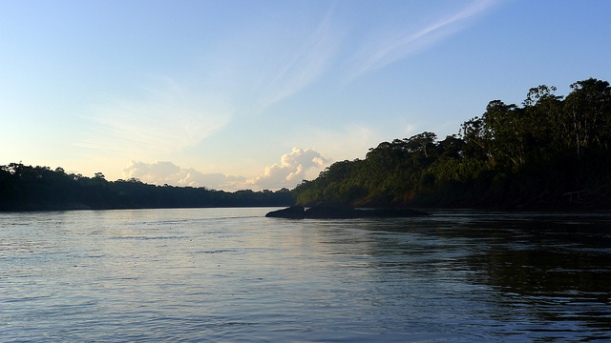For our last agricultural history lecture, we were fortunate to receive a guest speaker from the department who is involved in a mammoth project of mapping the world’s food systems across time. What an interesting pastime, but what a challenge! This is what I referred to in my last post – one of the off-hand things he said that really stuck with me was how mapping things doesn’t allow you to skip over things you aren’t sure about. If you write a book or article, you can just move from fact to fact, whereas with maps you are either left with huge white spaces or you have to make assumptions based on the best available evidence that might very well be wrong.
One question mark Professor Myrdal addressed is the state of the Amazon Basin before the arrival of European settlers. There are basically two large schools of thought:
The first, and prevailing for a long time, thought that there were basically only small hunter-gatherer communities who preserved the region as wilderness. This is also what my state of knowledge before the lecture was. After all, it’s called ‘untouched’ rainforest for a reason, right?

Turns out, this may or may not be the case – in the 1990s, archeological discoveries revealed large settlements and complex societies around the banks of the Amazon, spurring a second theory that there had been widespread clearing and management of forests connected to a first high day of agriculture in the centuries before Europeans came and brought diseases that swiftly wiped out these societies, leaving behind only remnants of their once flourishing society. In addition, a dig in 2010 found 90 settlements in areas that were far away from major waterways and that traditionally were perceived to have rather infertile soils – but apparently previous civilizations improved the soil in patches called “Terra Preta do Indio” (“Amazon Black Earth”).
This theory has huge implications for the resilience of rain forests: if they could really rebound rather quickly from an intensive burn-and-slash regime, they might (MIGHT) be less vulnerable than we think – though keep in mind that even if the theory holds true, this rebound necessitated the almost-complete elimination of the human influence on them. Plus, as our professor mentioned, there are even theories that link the regrowth of the rain forest with the climatic shifts during the Little Ice Age between the 16th and 19th century. There is so much we don’t know.
Including, in fact, the trust we can put in these historical theories one way or another. This article presents a new study from 2012 that found evidence contradicting the intensive-agriculture theory. Paleoecologists, archeobotanists and archeologists (such cool job titles) took soil samples from 55 different spots in the Amazon Basin and checked them for their charcoal content (evidence of burning) and plant fossil remains. Their conclusions were that humans had cleared and disturbed some parts of the forest there, but there was little evidence of farming. However, there is more controversy regarding both their methods and conclusions – understandably so, considering what rides on a settlement of the issue either way. As the scientists conclude:
“The amazing biodiversity of the Amazon is not a by-product of past human disturbance,” said McMichael. “We can’t assume that these forests will be resilient to disturbance, because most of them have, at most, been lightly disturbed in the past.
“There is no parallel in western Amazonia for the scale of modern disturbance that accompanies industrial agriculture, road construction and the synergies of those disturbances with climate change.”